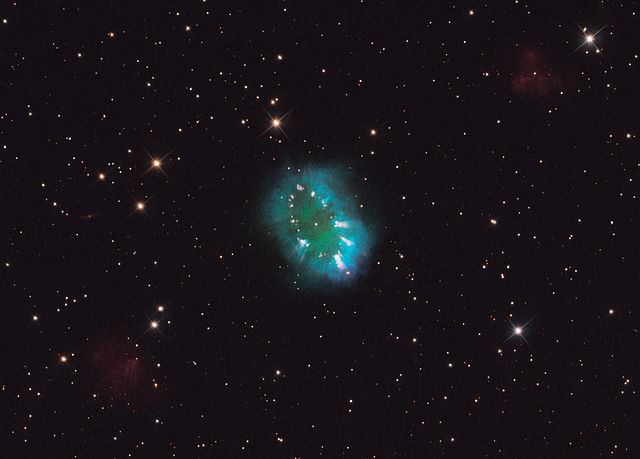 |
This is a file from the Wikimedia Commons. Information from its description page there is shown below.
Commons is a freely licensed media file repository. You can help.
|
Summary
| Description |
English: A giant cosmic necklace glows brightly in this NASA/ESA Hubble Space Telescope image.The object, aptly named the Necklace Nebula, is a recently discovered planetary nebula, the glowing remains of an ordinary, Sun-like star. The nebula consists of a bright ring, measuring about two light-years across, dotted with dense, bright knots of gas that resemble diamonds in a necklace. The knots glow brightly due to absorption of ultraviolet light from the central stars.
A pair of tightly orbiting stars produced the nebula, also called PN G054.2-03.4. About 10 000 years ago one of the aging stars ballooned to the point where it engulfed its companion star. The smaller star continued orbiting inside its larger companion, increasing the giant’s rotation rate, so that the bloated star span so fast that a large part of its gaseous envelope expanded into space. Most of the gas escaped along the star’s equator, producing a ring. The bright knots are dense gas clumps in the ring.
The pair is so close, only a few million kilometres apart, that they appear as one bright dot in the centre of this image. The stars are furiously whirling around each other, completing an orbit in a little more than a day. For comparison, Mercury, the innermost planet of our Solar System, orbits the Sun in 88 days. The Necklace Nebula is located 15 000 light-years away in the constellation of Sagitta (The Arrow). In this composite image, taken on 2 July, Hubble’s Wide Field Camera 3 captured the glow of hydrogen (blue), oxygen (green), and nitrogen (red).
|
| Date |
15 August 2011 |
| Source |
http://www.spacetelescope.org/images/potw1133a/ |
| Author |
NASA, ESA and the Hubble Heritage Team (STScI/AURA) |
Licensing

 |
This file is licensed under the Creative Commons Attribution 3.0 Unported license. |
|
|
|
- You are free:
- to share – to copy, distribute and transmit the work
- to remix – to adapt the work
- Under the following conditions:
- attribution – You must attribute the work in the manner specified by the author or licensor (but not in any way that suggests that they endorse you or your use of the work).
http://creativecommons.org/licenses/by/3.0 CC-BY-3.0 Creative Commons Attribution 3.0 truetrue
|
File usage
The following pages on Schools Wikipedia link to this image (list may be incomplete):
This file contains additional information, probably added from the digital camera or scanner used to create or digitize it. If the file has been modified from its original state, some details may not fully reflect the modified file.


